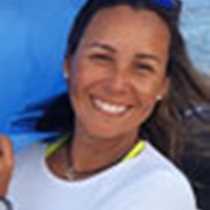Wow! There is no other way to describe the fantastic day we had. Today we reached the central area of the Galápagos, and our first island was Sombrero Chino, a small spatter cone off the coast of Santiago Island. Dividing both islands is a channel with crystal-clear turquoise waters. Just after breakfast, we left the National Geographic Islander to explore the coastline from our Zodiacs. Our goal: to find the elegant Galápagos penguins. A small colony inhabits this area, and since the weather conditions were clear and sunny, many were already in the water chasing the little fish. One penguin seemed to have had enough and gave us the wonderful opportunity of photographing it standing on some rocks. What a treat!
We returned after a while to snorkel along the coast. The visibility was great, and the water was inviting. Our fearless snorkelers were soon enjoying the many fish species that inhabit this area: razor surgeonfish, Panamic sergeant majors, parrot fishes, and many more. A few were fortunate to have a close encounter with a black-tipped reef shark, too, while some Galápagos penguins swam speedily by, chasing their prey at amazing speed. But snorkeling was not the only option in the morning, and many set off to relax and enjoy the colorful beach of Sombrero Chino. After all, this is vacation time!
By midday, with everyone back on board, the captain navigated us close to Bainbridge Rocks. One of these rocks has a crater filled with water and it was quite stunning to see it from the highest deck of our beautiful ship. But an amazing surprise was waiting for us just after lunch. Not far from our next anchorage site, the deck officers spotted a couple of orcas, also known as killer whales. Swiftly, all of our Zodiacs were lowered so we could get closer to them. A large flock of various sea birds flew over the orcas, a clear sign that these phenomenal predators were feeding on some marine creature; the birds simply were making the most of the scraps. At one point we caught up with them and observed an orca swallowing a marine turtle! This was a unique opportunity to witness the power of the killer whale, which many have only seen on TV documentaries ... simply amazing.
After feeding, the killer whales continued along the northern coast of Santiago and we returned to our ship to drop anchor further south at Sullivan Bay. After a mini-siesta and a short shopping spree at our onboard Global Gallery, we disembarked in totally different surroundings. Sullivan is part of a massive lava flow that dates back to only 1897. Therefore, there has been no time for erosion to happen, so the flow is still quite intact as if it had solidified only yesterday. Many volcanic features and textures were below our feet: patches of intricate pahoehoe or ropy lavas as well as the jagged and treacherous A-A lavas. Toward the back of the flow, there are older lavas of variegated reddish colors and different textures, indicative of previous eruptions. The place feels quite inhospitable, and just a few species have been able to colonize it due to the lack of soil and little rain. The only plants seen on the lava field were pioneers like the mollugo and the lava cactus. A few endemic painted locusts and Galápagos doves were in the vicinity, but in low numbers. With the unusual surroundings, we easily felt like we had stepped back in time. This was another magnificent day in the Enchanted Islands, full of wildlife, colors and wonderful experiences only found in this remote corner of planet Earth.







